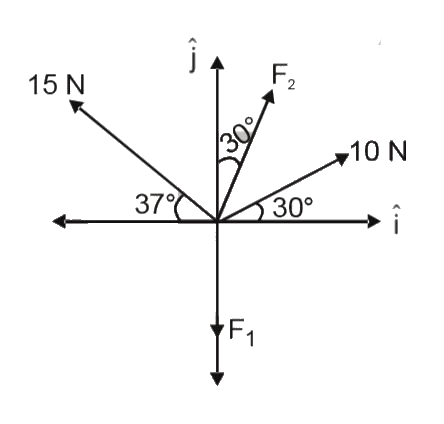A vector →F1 is along the positive X-axis. If its vector product with another vector product with another vector →F2 is zero then →F2 may be:Solution in Gujrati
The correct Answer is:4
Let →F1=kˆi∵→F1×→F2=0
→F2 may be in x-direction
So →F2=−4ˆi
Topper's Solved these Questions
- BASIC MATHEMATICS USED IN PHYSICS &VECTORS BOOK - ALLEN CHAPTER - BASIC MATHEMATICS USED IN PHYSICS &VECTORS EXERCISE - EXERCISE-II AIPMT/NEET & AIIMS (2006- 2018)
6 Videos
- BASIC MATHEMATICS USED IN PHYSICS &VECTORS BOOK - ALLEN CHAPTER - BASIC MATHEMATICS USED IN PHYSICS &VECTORS EXERCISE - EXERCISE-III CHECK YOUR UNDERSTANDING
15 Videos
- BASIC MATHEMATICS USED IN PHYSICS &VECTORS BOOK - ALLEN CHAPTER - BASIC MATHEMATICS USED IN PHYSICS &VECTORS EXERCISE - DOT PRODUCT
20 Videos
- CENTRE OF MASSBOOK - ALLEN CHAPTER - CENTRE OF MASSEXERCISE - EXERCISE-V B
19 Videos
Similar Questions
The vector →A and →B are such that ∣∣→A+→B∣∣=∣∣→A−→B∣∣. The angle between vectors →A and →B is -
View SolutionThe moon's distance from the earth is 360000 km and its diameter subtends an angle of 42' at the eye of the observer. The diameter of the moon is
View SolutionWhat is the angle between →A and the resultant of (→A+→B) and (→A−→B) ?
View SolutionTwo particles of masses m1 and m2 in projectile motion have velocities →v1 and →v2 , respectively , at time t=0. They collide at time t0. Their velocities become →v'1 and →v'2 at time 2t0 while still moving in air. The value of ∣∣∣(m1→v'1+m2→v'2)−(m1→v1+m2→v2)∣∣∣
View SolutionConsider two vectors →F1=2ˆi+5ˆk and →F2=3ˆj+4ˆk. The magnitude to thhe scalar product of these vectors is
View SolutionA vector →F1 is along the positive X-axis. If its vectors product with another vector →F2 is zero then →F2 could be
View SolutionWhich of the four arrangements in the figure correctly shows the vector addition of two forces vecF_(1) and vecF_(2) to yield the third force vecF_(3)
View SolutionA vector →F1 is along the positive X-axis. If its vectors product with another vector →F2 is zero then →F2 could be
View SolutionAssertion: The dot product of one vector with another vector may be scalar or a vector.
Reason: If the product of two vectors is a vector quantity, then product is called a dot product.
View SolutionA vector →A is along the positive x-axis and its vector product with another vector →B is zero, then vector →B could be
View SolutionIf the four forces as shown are in equilibrium Express →F1&→F2 in unit vector form.

View SolutionIf the four forces as shown are in equilibrium Express vecF_(1)& vecF_(2) in unit vector form.
View SolutionA vector →A is along the positive z-axis and its vector product with another vector →B is zero, then vector →B could be :
View SolutionCompare the components of vector equation vecF_(1)+vecF_(2)+vecF_(3)=vecF_(4) .
View SolutionA vector vec(A) is along the positive x-axis and its vector product with another vector vec(B) is zero, then vector vec(B) could be
View SolutionA vector →A is along the positive z-axis and its vector product with another vector →B is zero, then vector →B could be :
View Solution
